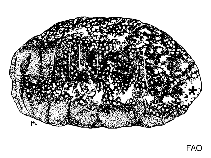Holothuria inhabilis Selenka, 1867
| Native range | All suitable habitat | Point map | Year 2050 |

|
| This map was computer-generated and has not yet been reviewed. |
| Holothuria inhabilis AquaMaps Data sources: GBIF OBIS |
Mandar um arquivo com seu (sua) Fotos
Imagem do Google | No image available for this species;
drawing shows typical species in Holothuriidae.
Imagem do Google | No image available for this species;
drawing shows typical species in Holothuriidae.
Classification / Names Common names | Synonyms | CoL | ITIS | WoRMS
| Holothuriida | Holothuriidae
Environment: milieu / climate zone / depth range / distribution range Ecologia
; intervalo de profundidade 1 - 200 m (Ref. 81020). Tropical
Distribuição Países | Áreas FAO | Ecossistemas | Ocorrências | Introduções
Indo-Pacific: China, Philippines, Australia, South East Arabia, East Indies and Pacific Islands.
Length at first maturity / Tamanho / Peso / Idade
Maturity: Lm ? range ? - ? cm Max length : 15.0 cm TL macho/indeterminado; (Ref. 800)
Minimum depth from Ref. 83942.
Life cycle and mating behavior Maturidade | Reprodução | Desova | Ovos | Fecundidade | Larvas
Members of the class Holothuroidea are gonochoric and have only one gonad. Spawning and fertilization are both external and some exhibit brooding. Life cycle: Embryos develop into planktotrophic larvae (auricularia) then into doliolaria (barrel-shaped stage) which later metamorphose into juvenile sea cucumbers.
Referência principal
Referências | Coordenador | Colaboradores
Schoppe, S. 2000. (Ref. 800)
Status na Lista Vermelha da IUCN (Ref. 130435)
Segura ou pouco preocupante (LC) ; Date assessed: 19 May 2010
Status no CITES (Ref. 108899)
Not Evaluated
CMS (Ref. 116361)
Not Evaluated
Perigo para os humanos
Harmless
Uso pelos humanos
| FishSource |
Ferramentas
Mais informação
Fontes da internet
BHL | BOLD Systems | CISTI | DiscoverLife | FAO(Publication : search) | Fishipedia | GenBank (genoma, nucleotídeo) | GloBI | Gomexsi | Google Books | Google Scholar | Google | PubMed | Árvore da vida | Wikipedia (Ir para, procura) | Registro zoológico
Estimates based on models
Preferred temperature
(Ref. 115969): 21.4 - 28.3, mean 27 (based on 711 cells).
Categoria de preço
(Ref. 80766):
Unknown.



